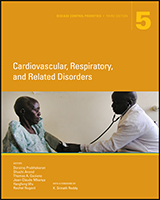Cardiovascular, respiratory, and related disorders (CVRDs) and conditions are responsible for a significant portion of the world’s health burden. In 2012, 52 percent of global adult deaths were caused by CVRDs, and most occurred in low- and middle-income settings. Most CVRDs and related disorders are preventable or can be treated to reduce morbidity. Doing so, however, requires greater capacity to detect and treat at an early stage, as they are often “silent” diseases. These conditions also threaten economic development due to reduced productivity among those affected with illness and early death, as well as high household treatment costs that are often paid out of pocket in low-resource settings. Combined with the enduring presence of infectious diseases, such as tuberculosis and HIV/AIDS, CVRDs in low-income countries create a double burden of disease.
The Cardiovascular, Respiratory, and Related Disorders volume of DCP3 contributes to existing research efforts in several ways:
By summarizing the best available evidence for effective and scalable interventions
By identifying the most effective and cost-effective priority interventions
By describing the health platforms that can deliver these interventions and thereby curtail the increasing risk for chronic conditions and diseases.
The volume also provides an essential package of policy and health interventions that are cost-effective and feasible in lower-middle-income countries and can significantly reduce the health burden of these diseases.
We focus primarily on cardiovascular diseases and the primary risks—including ischemic heart disease, stroke, and congestive heart failure—as well as secondary risk factors, such as tobacco use, physical activity, and obesity. We also include three other major chronic conditions: respiratory diseases, diabetes, and kidney disease. These conditions share risk factors and are often precursors for one another, and we address treatment and prevention of these conditions together. Cancer and mental health, typically grouped among noncommunicable diseases, are covered in DCP3 volumes three and four, respectively.
This volume finds that effective prevention strategies are often underused in countries at all income levels. Substantial progress against CVRDs has been achieved in high- and upper-middle-income countries, partly as the result of policies that are applied at the population level—such as tobacco taxation or bans on trans-fats—and partly due to the availability of cost-effective pharmacological treatments. These policies have not been widely implemented in lower-income countries. This volume’s essential package recommends 36 policy and health system interventions using primary health service delivery platforms. This set of interventions is focused on population prevention, as well as on targeting high-risk populations in LMICs to prevent and reduce early mortality from CVRDs.
The editors and authors of Cardiovascular, Respiratory, and Related Disorders hope that this volume can serve as a basis for universal health care packages. As countries strengthen their health systems and economic resources become more available, this essential package can be expanded to encompass more resource-intensive, life-saving interventions.
We thank the following individuals who provided valuable comments and assistance on this effort: Brianne Adderley, Kristen Danforth, Dean T. Jamison, Shamelle Richards, and Shivali Suri. We particularly acknowledge Jinyuan Qi for her assistance in preparing the Essential Package cost estimates. The editors also thank the reviewers organized by the U.S. National Academy of Medicine (listed separately in this volume), and the Advisory Committee to the Editors of DCP3 for thoughtful feedback on the essential package.
Dorairaj Prabhakaran
Shuchi Anand
Thomas A. Gaziano
Jean-Claude Mbanya
Yangfeng Wu
Rachel Nugent

